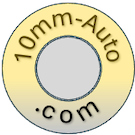My project: Loaded 10mm Auto cartridges with 155 gr. pure zinc bullets from Mid-South Shooters Supply. Data:
155 gr. pure zinc bullet RNFP
6.9 gr. Vihtavuori 3N37
WW LP primer
Starline brass
OAL 1.265
Muzzle velocity 1078
Previously fired in Ruger SR1911
These 155 gr. bullets inasmuch as they made of zinc are significantly longer than equivalent weight bullets in lead or jacketed lead. Therefore, powder selection is important because a fluffy or bulky powder might result in a compressed load (which I never personally like). This was a comfortable, smooth, mild load. Obviously not for hunting but surely suitable for targets of another sort. No residue of any kind left in the bbl. after firing.
I much prefer the 10mm Auto over .40 S&W. Why? Because the .40 is more limited in capability. The 10, you can load it down and make it behave like a .40, or go right up the power ladder to some pretty stout loads. The 10 is way more versatile.
The zinc bullets are part of my exploration of alternative projectile materials. Non toxic shot is already required by the feds for hunting migratory birds. Many states have their own restrictions on lead shot for other hunting purposes. California already has a lead bullet ban in some areas, non-lead ammunition for all hunting will be required there beginning July 1, 2019. A number of states recommend non-toxic bullets for hunting. We can see what's coming. So I'm checking out the alternatives, such as copper solids, frangible bullets, and even these zinc bullets. Which were fairly inexpensive at $10 the hundred.
155 gr. pure zinc bullet RNFP
6.9 gr. Vihtavuori 3N37
WW LP primer
Starline brass
OAL 1.265
Muzzle velocity 1078
Previously fired in Ruger SR1911
These 155 gr. bullets inasmuch as they made of zinc are significantly longer than equivalent weight bullets in lead or jacketed lead. Therefore, powder selection is important because a fluffy or bulky powder might result in a compressed load (which I never personally like). This was a comfortable, smooth, mild load. Obviously not for hunting but surely suitable for targets of another sort. No residue of any kind left in the bbl. after firing.
I much prefer the 10mm Auto over .40 S&W. Why? Because the .40 is more limited in capability. The 10, you can load it down and make it behave like a .40, or go right up the power ladder to some pretty stout loads. The 10 is way more versatile.
The zinc bullets are part of my exploration of alternative projectile materials. Non toxic shot is already required by the feds for hunting migratory birds. Many states have their own restrictions on lead shot for other hunting purposes. California already has a lead bullet ban in some areas, non-lead ammunition for all hunting will be required there beginning July 1, 2019. A number of states recommend non-toxic bullets for hunting. We can see what's coming. So I'm checking out the alternatives, such as copper solids, frangible bullets, and even these zinc bullets. Which were fairly inexpensive at $10 the hundred.
